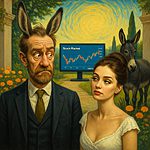Lone Wolf Mentality: The Unspoken Edge of the Exceptional Investor
April 1, 2025
In a world wired for conformity, the rarest alpha is often found in isolation. The Lone Wolf Mentality isn’t just a poetic idea—it’s a strategic weapon in the financial arena. When mobs chase momentum and analysts echo recycled noise, lone wolves quietly sharpen their claws. They know the crowd is often late, loud, and wrong.
This essay examines the mindset that rejects the herd, dissects consensus, and trades clarity for comfort. We’ll unravel its overlap with mob psychology, cognitive bias, and unconventional analysis. It’s a playbook for those unwilling to outsource their thinking and who prefer conviction over applause.
The Core of the Lone Wolf Investor
This mentality embodies intellectual autonomy, resilience, and a defiant commitment to original thought. It’s not just about swimming upstream—it’s about understanding why the river flows that way in the first place.
Forget Leonardo. Let’s bring in Nassim Taleb, whose disdain for mainstream thinking mirrors the lone wolf’s worldview. His stance: “If you see fraud and do not say fraud, you are a fraud.” Replace fraud with irrational euphoria—or panic—and you’ve captured the essence of the lone wolf investor.
The archetype includes:
- Ruthless Independent Thinking – Driven by deep analysis, not financial media or market noise.
- Contrarian Instinct – This is not for show but because they understand how groupthink and recency bias distort risk perception.
- Calculated Risk Appetite – They’re not gamblers, but they don’t flinch from sharp drawdowns when their thesis is intact.
- Insatiable Curiosity – Markets change; so does their model. They evolve or get eaten.
- Emotional Antifragility—While others seek validation, they find strength in solitude. Criticism is expected, and praise is suspicious.
Mass Psychology: The Market’s True Engine
This path comes with landmines. The biggest risk isn’t just being wrong—it’s believing you’re right without realizing you’re trapped in your own echo chamber.
The crowd is reactive. It chases narratives, not data. It anchors to price, succumbs to confirmation bias, and treats volatility as danger rather than opportunity. The lone wolf sees what the crowd refuses to see—how emotion hijacks logic and distorts market signals.
They exploit this dissonance. When panic bleeds into prices or euphoria inflates bubbles, lone wolves don’t predict—they prepare. They watch for inflection points born from sentiment extremes, not earnings reports.
Mob Psychology vs. The Lone Wolf: Breaking from the Herd
One of the lone wolf’s sharpest advantages lies in its immunity to mob-driven distortions. When the crowd loses its grip on logic—swinging between euphoric greed and panicked despair—the lone wolf steps back, studies the emotional tide, and prepares to strike where others flee or fumble.
Mob psychology thrives in markets because humans are wired for safety in numbers. It’s a survival instinct turned financial liability. What starts as group consensus can mutate into irrational feedback loops, reinforced by news cycles, echo chambers, and the ever-tempting fear of missing out. This is where cognitive biases like anchoring, herd behavior, and confirmation bias hijack rational thought.
Forget Aristotle. Let’s bring in Gustave Le Bon, the father of crowd psychology. He understood that, “In crowds, it is stupidity and not mother-wit that is accumulated.” The market reflects this all too well. When valuations disconnect from reality or mass panic drives quality assets into the ground, lone wolves don’t panic—they prepare.
Take the dot-com bubble. As the crowd tossed logic aside in favor of hype, investors like David Einhorn and Michael Burry questioned the narrative. While others celebrated surface-level growth, they saw the cracks beneath. The payoff came not in applause—but in profit.
Technical Analysis with a Lone Wolf Filter
While many cling to indicators as if they were gospel, the lone wolf treats technical analysis as a tool—not a crutch. They understand that most traders use the same signals the same way—which nullifies their edge.
Von Neumann’s line—“Anyone who attempts to generate random numbers by deterministic means is, of course, living in a state of sin”—captures this perfectly. You can’t use yesterday’s patterns to forecast tomorrow’s chaos without context, curiosity, and constant adaptation.
Lone wolves go deeper:
- They question why patterns form, and when they’ll fail.
- They combine price action with sentiment extremes, liquidity flows, and structural breaks—not just lines and squiggles.
- Some build their own indicators. Others rip apart standard ones to spot crowded trades and technical traps.
Innovation and Out-of-the-Box Strategy
This mindset naturally births innovation. Lone wolves aren’t married to tradition; they’re obsessed with truth—wherever it hides.
Rather than Marie Curie, who belongs to a different arena, let’s look to Richard Feynman, who warned: “The first principle is that you must not fool yourself—and you are the easiest person to fool.” That’s the code lone wolves live by. They innovate not out of vanity, but necessity—because mainstream strategies often fail in nonlinear markets.
Look at James Simons of Renaissance Technologies. He didn’t come from Wall Street. He came from pure math and built one of the most secretive, wildly successful quant funds ever. Or Amy Domini, who saw potential in values-aligned investing before ESG became a marketing buzzword. They didn’t follow—they created new playbooks.
The common thread? They asked different questions and refused to let crowd consensus dictate their strategy.
The Price of Thinking Differently
Shakespeare’s words—“The fool doth think he is wise, but the wise man knows himself to be a fool”—remain timeless. In markets, this means recognizing that confidence without humility is a recipe for disaster.
Here are the key pitfalls:
- Confirmation Bias – Filtering out facts that challenge your thesis.
- Overconfidence – Confusing conviction with clairvoyance.
- Opportunity Cost – Avoiding mainstream trades just because they’re popular.
- Emotional Isolation – The grind of standing alone during prolonged drawdowns.
- Limited Resources – Competing with institutions armed with teams and tech.
The smartest lone wolves build systems to challenge their own assumptions. They seek friction. They don’t fear being wrong—they fear not knowing when they are.
Some build small circles of contrarian thinkers. Others use AI, data tools, or even old-school journaling to map patterns in their thinking. The end goal is the same: keep evolving without becoming the crowd you once fled.
Historical Precedents and Lessons
Swimming upstream isn’t about ego. It’s about clarity. Most follow noise. A few chase signals. The lone wolf? They don’t move until they’ve vetted the source.
Jesse Livermore bet big, made fortunes, and lost them too—but his blueprint for independent analysis still echoes. John Templeton bought when bombs were falling, not when CNBC turned bullish. Their wins were earned, not copied.
And yet—they weren’t invincible. Livermore fell to hubris. Templeton learned through pain. The lesson? Independence must be tempered by discipline.
Lone Wolves in the Now
In a world drowning in data, the real edge is interpretation. Today’s markets are faster, more complex, and more opaque. It’s no longer enough to think differently—you’ve got to think deeper.
Imhotep didn’t separate disciplines—he fused them. That’s the model. Markets don’t move on charts alone. They move on liquidity, politics, sentiment, and anomaly. The lone wolf of today blends all of it—like a one-man think tank.
Key tactics:
- Forge your own lens: Build a framework that fits your mind, not someone else’s playbook.
- Use tech as leverage: AI, screeners, NLP—whatever gives you signal before the crowd sees it.
- Source widely, think narrowly: Read broadly. Act selectively.
- Game the future: Use scenario planning to prepare for what might unfold—not just what has.
- Find sharp minds: Collaboration isn’t weakness—it’s intel. But choose your circle wisely.
In Summing Up
Lone wolves don’t rebel for the sake of rebellion. They just refuse to outsource their thinking. They win not by being louder but by being right when it matters.
Final Thoughts
The lone wolf doesn’t rebel for style. They rebel because obedience is expensive.
This path isn’t made for comfort—it’s carved for clarity. It demands thick skin, sharp focus, and an internal compass immune to the market’s daily noise. While most chase narratives, the lone wolf builds systems. While others react, they anticipate.
Howard Marks nailed it: “You can’t do the same things others do and expect to outperform.” That’s not just a warning—it’s a challenge.
Most will follow. A few will think. But only a rare breed dares to stand alone, synthesize chaos into clarity, and act when the crowd is paralyzed. That’s the lone wolf edge—earned in silence, proven in results.
They don’t seek attention. They seek truth. And when they strike, they strike hard—not with noise, but with precision.
In markets ruled by fear, illusion, and imitation, the lone wolf isn’t just different.
They’re dangerous.















